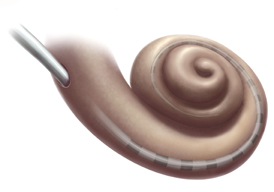A New Twist to the Cochlea: Why It’s Shaped the Way It Is

The mammalian cochlea is spiral-shaped, like a snail shell.
For years, scientists have believed that the distinctive snail shape of the mammalian cochlea – in contrast to the stretched-out versions found in birds or reptiles – is useful for packing a slew of hearing parts into a very small space. Now, Dr. Daphne Manoussaki, Vanderbilt University, together with NIH researchers Dr. Richard Chadwick, NIDCD, and Dr. Emilios K. Dimitriadis, Office of Research Services, have demonstrated another benefit to its tightly-wound shape: the better to hear low-pitched (or low-frequency) sounds. Their paper is published in the March 2, 2006, online issue of Physical Review Letters.
Though the cochlea looks fairly simple, it’s surprisingly complex. A fluid-filled organ with an elastic “basilar” membrane running down its length, the cochlea is responsible for converting sound energy into electrical signals that travel to the brain. It accomplishes this in two stages. Sound vibrations enter the cochlea by way of the bones of the middle ear, causing the fluid inside to ripple and a traveling wave to form along the basilar membrane. Hair cells, sensory cells sitting atop the basilar membrane, “ride the wave,” bending against an overlying membrane and generating an electrical signal. Because the basilar membrane is fine-tuned to respond to certain frequencies at specific positions, hair cells near the base, or large end, of the cochlea detect higher-pitched sounds, such as a cell phone ringing, and those nearer the apex, or centermost point, detect lower-pitched sounds, such as a kettle drum or the call of a blue whale.
Starting with a simple model of a spiral, the research team calculated how the cochlea’s curve affects the movement of sound energy inside the inner ear. Like the Whispering Gallery in St. Paul’s Cathedral in London, whereby a whispered voice travels along the curved wall to be heard on the opposite side of the room, the researchers found that sound energy preferentially travels along the outer wall of the cochlea. As this occurs, the fluid sloshes higher on one side, the basilar membrane wave tilts more to one side, and the hair cells, which are sensitive to motion at right angles to the direction of the wave, get an added push, causing them to bend. The effect is strongest at the center of the spiral, where the lowest frequencies are detected, said the researchers, who calculated an increase in sensitivity by as much as 20 decibels. The ability to hear low-frequency sounds, which travel the farthest of all sounds, is especially important to mammals for communication and survival.